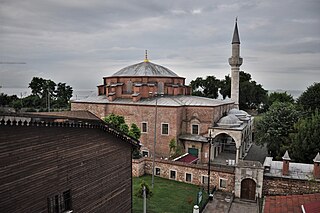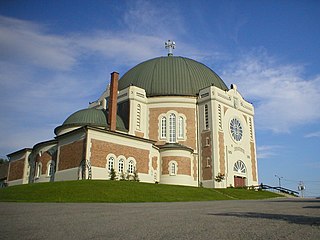
Hagia Sophia, officially the Hagia Sophia Grand Mosque, is a mosque and a major cultural and historical site in Istanbul, Turkey. The last of three church buildings to be successively erected on the site by the Eastern Roman Empire, it was completed in 537 AD. The site was an Eastern Orthodox church from 360 AD to 1204, when it was converted to a Catholic church following the Fourth Crusade. It was reclaimed in 1261 and remained Eastern Orthodox until the Ottoman conquest of Constantinople in 1453. It served as a mosque until 1935, when it became a museum. In 2020, the site once again became a mosque.

Cathedrals, collegiate churches, and monastic churches like those of abbeys and priories, often have certain complex structural forms that are found less often in parish churches. They also tend to display a higher level of contemporary architectural style and the work of accomplished craftsmen, and occupy a status both ecclesiastical and social that an ordinary parish church rarely has. Such churches are generally among the finest buildings locally and a source of regional pride. Many are among the world's most renowned works of architecture. These include St Peter's Basilica, Notre-Dame de Paris, Cologne Cathedral, Salisbury Cathedral, Antwerp Cathedral, Prague Cathedral, Lincoln Cathedral, the Basilica of Saint-Denis, Santa Maria Maggiore, the Basilica of San Vitale, St Mark's Basilica, Westminster Abbey, Saint Basil's Cathedral, Antoni Gaudí's incomplete Sagrada Família and the ancient cathedral of Hagia Sophia in Istanbul, now a mosque.

Byzantine architecture is the architecture of the Byzantine Empire, or Eastern Roman Empire, usually dated from 330 AD, when Constantine the Great established a new Roman capital in Byzantium, which became Constantinople, until the fall of the Byzantine Empire in 1453. There was initially no hard line between the Byzantine and Roman Empires, and early Byzantine architecture is stylistically and structurally indistinguishable from late Roman architecture. The style continued to be based on arches, vaults and domes, often on a large scale. Wall mosaics with gold backgrounds became standard for the grandest buildings, with frescos a cheaper alternative.

The Franciscan Monastery of the Holy Land in America is a Franciscan complex at 14th and Quincy Streets in the Brookland neighborhood of Northeast Washington, D.C. Located on a hill called Mount Saint Sepulcher, and anchored by the Memorial Church of the Holy Sepulcher, it includes gardens, replicas of various shrines throughout Israel, a replica of the catacombs in Rome, an archive, a library, as well as bones of Saint Benignus of Armagh, brought from the Roman catacombs and originally in the cathedral of Narni, Italy.

Neo-Byzantine architecture was a revival movement, most frequently seen in religious, institutional and public buildings. It incorporates elements of the Byzantine style associated with Eastern and Orthodox Christian architecture dating from the 5th through 11th centuries, notably that of Constantinople and the Exarchate of Ravenna.

Hagia Irene or Hagia Eirene, sometimes known also as Saint Irene, is an Eastern Orthodox church located in the outer courtyard of Topkapı Palace in Istanbul. It is the oldest known church in the city and the only Byzantine church in Istanbul that was never converted into a mosque, as it was used as an arsenal for storing weapons until the 19th century. The Hagia Irene today operates as a museum and concert hall.

The Saint Sofia Church is the oldest church in the Bulgarian capital Sofia, dating to the fourth century. In the predecessor building took place the Council of Serdica held most probably in 343 and attended by 316 bishops. In the 14th century, the church gave its name to the city, previously known as Serdika (Сердика).

The conversion of non-Islamic places of worship into mosques occurred during the life of Muhammad and continued during subsequent Islamic conquests and under historical Muslim rule. Hindu temples, Jain Temples, Christian churches, synagogues, and Zoroastrian fire temples have been converted into mosques.

St. Michael the Archangel's Church or the Garrison Church is a Roman Catholic church in the city of Kaunas, Lithuania, closing the perspective of the Laisvės alėja, the main pedestrian street. It was built between 1891 and 1895 when Kaunas was part of the Russian Empire, in Neo-Byzantine style largely for the use of the Russian Orthodox garrison of Kaunas Fortress.

St. Francis de Sales Roman Catholic Church, founded in 1890, is a Catholic church at 4625 Springfield Avenue in Philadelphia, Pennsylvania, part of the Roman Catholic Archdiocese of Philadelphia. Its cornerstone laid in 1907, the Guastavino tiled dome of the de Sales parish has been an icon in its neighborhood. The de Sales parish was designed by Philadelphia architect Henry D. Dagit, built in the Byzantine Revival style and incorporates a Guastavino tile dome modeled on that of Istanbul's Hagia Sophia and elements of the Arts and Crafts movement which was at its peak when the church was built.

The Little Hagia Sophia mosque, formerly the Church of Saints Sergius and Bacchus, is a former Greek Orthodox church dedicated to Saints Sergius and Bacchus in Constantinople, built between 532 and 536, and converted into a mosque during the Ottoman Empire.

Kalenderhane Mosque is a former Eastern Orthodox church in Istanbul, converted into a mosque by the Ottomans. With high probability the church was originally dedicated to the Theotokos Kyriotissa. The building is sometimes referred to as Kalender Haneh Jamissi and St. Mary Diaconissa. This building represents one among the few extant examples of a Byzantine church with domed Greek cross plan.

Russian-Byzantine architecture is a revivalist direction in Russian architecture and decorative and applied arts, based on the interpretation of the forms of Byzantine and Ancient Russian architecture. As part of eclecticism could be combined with other styles.

In architecture, a semi-dome is a half dome that covers a semi-circular area in a building.

The Church of St. Anselm is a Roman Catholic parish church under the authority of the Roman Catholic Archdiocese of New York, located at 685 Tinton Avenue in the Mott Haven neighborhood of the Bronx in New York City. It was established in 1891 and is staffed by the Order of Augustinian Recollects. Previously it was staffed by the Benedictine monks.

Domes were a characteristic element of the architecture of Ancient Rome and of its medieval continuation, the Byzantine Empire. They had widespread influence on contemporary and later styles, from Russian and Ottoman architecture to the Italian Renaissance and modern revivals. The domes were customarily hemispherical, although octagonal and segmented shapes are also known, and they developed in form, use, and structure over the centuries. Early examples rested directly on the rotunda walls of round rooms and featured a central oculus for ventilation and light. Pendentives became common in the Byzantine period, provided support for domes over square spaces.

The Cathedral of St. Teresa of Avila is the cathedral of the Roman Catholic Diocese of Amos, which encompasses western and northern Quebec, Canada. It is located in the center of Amos, on the east bank of the Harricana River on the highest hill of the town, and visible for a great distance. It is the only Catholic cathedral in the Abitibi-Témiscamingue region.

The Church of Hagia Sophia or Holy Wisdom is a Byzantine church in the fortified medieval town of Mystras, Peloponnese, Greece. It forms part of the wider archaeological site of Mystras, which is designated as a World Heritage Site by UNESCO. Built within the palace complex, it functioned as the royal palace church until Ottoman conquest of Mystras and its conversion into an Islamic mosque. Hagia Sophia of Mystras was made back into a Christian church when Greece achieved independence during the early eighteenth century.

The Church of Hagia Sophia or Holy Wisdom is a Byzantine church in the medieval town of Monemvasia, Peloponnese, Greece. It forms part of the wider archaeological site of Monemvasia. It was built on the upper town of Monemvasia, and was originally dedicated to Panagia Hodegetria. It is the most important monument of Monemvasia. The Venetians, who held Monemvasia for some time, used it as a Catholic church dedicated to Madonna, while during the Ottoman period it was converted into a mosque before being restored to Christian worship upon Greece's independence.

The Church of Hagia Sophia or Holy Wisdom is a 10th-century Byzantine church in the town of Drama, Greece.





















